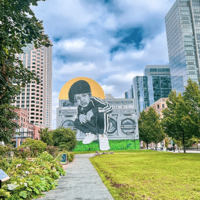The Art of Possibility: Book Review and What I Learned
The Art of Possibility offers a mind-bending approach to seeing perceived limitations in a new way. By stretching our definitions of ourselves and taking more responsibility for EVERYTHING in our lives, we can enter a world of infinite possibilities.
Here are the main points I got out of every chapter:
(All quotes below are from The Art of Possibility)
Chapter 1. It’s All Invented
“When you bring your mind to it’s all invented, you remember that it’s all a story you tell – not just some of it, but all of it.”
Our minds seek and depend on mental constructs, and we create and invent the stories we tell ourselves about everything in our lives. The authors state that premise is the foundational driving force of the book.
Chapter 2. Stepping into a Universe of Possibility
This chapter encourages us to step from a ‘world of measurement’ into a ‘universe of possibility.’ This universe of possibility “stretches beyond the world of measurement to include all worlds: infinite, generative, and abundant.”
I love the talk about a generative universe in which we are encouraged to contribute and give what we have to offer. This leads to a notion of an infinitely abundant universe to which we hold the key to many solutions before us.
Chapter 3. Giving an A
By Giving an A, we’re acknowledging that the people in our lives, including ourselves, are good and worthy. It places us on the same level as everyone and encourages us to work together to accomplish goals.
“Giving an A is an enlivening way of approaching people that promises to transform you as well as them.”
By giving an A you assume the best in others.
So much unnecessary pain and suffering are caused by placing our preconceived notions on what other people say and do. We have another choice. We can instead assume the best in others and be surprisingly amazed by what we discover.
Chapter 4. Being a Contribution
“Naming oneself and others as a contribution produces a shift away from self-concern and engages us in a relationship with others that is an arena for making a difference.”
This is one of my favorite takeaways from The Art of Possibility.
Benjamin Zander tells a story of how he begrudgingly went to speak to a nursing home community and how, to his surprise, incredibly joyful he was by the end of the talk. Contributing to the group, and impacting one person in particular, offered a transcendent moment of joy.
Being a contribution turns our notion of what’s important upside down. It’s not always just about little me. It’s about what I have to offer in every situation.
Chapter 5. Leading from Any Chair
In this chapter, the authors describe how leading isn’t what it seems. We are all leaders, and what we think and feel matters.
Chapter 6. Rule Number 6
This rule is simple: Don’t take yourself so seriously.
“When one person peels away layers of opinion, entitlement, pride, and inflated self-description, others instantly feel the connection. With the calculating self revealed and humored, the central self shines through.”
The authors share how “taking ourselves seriously” locks us more into the measurement world. We evaluate ourselves, constantly measuring our strengths and weaknesses.
Yet, when we let go of these rules and expectations, we can access a transformative central self that connects with and moves through life more easily.
Chapter 7. The Way Things Are
“Being present to the way things are means being present without resistance: being present to what is happening and to your reactions, no matter how intense.”
This is a powerful lesson. When aligned with what is, we can work with whatever is happening to us instead of resisting it.
“Being with the way things are calls for an expansion of ourselves. We start from what is, not what should be; we encompass contradictions, painful feelings, fears, and imaginings, and- without fleeing, blaming, or attempting correction- we learn to soar, like the far-seeking hawk, over the whole landscape.”
Many gifts, insights, and possibilities we haven’t considered alight our minds when we’re present with the way things are.
Chapter 8. Giving Way to Passion
Rosamund Stone Zander shares a story of an acutely intense experience of nature while on a hike. She then follows with:
“When I began to paint later that day, I found that the momentum of nature showed up on the canvas; not the object, the lines, or the color, but dynamic forces, geometric vibrancy, the passion of color.”
This chapter shares that just beyond what we can experience with our senses exists a world of magical, unleashed passion that can elevate our potential to another new level.
There is an infinite vibrancy, and pure energy, just beyond our sight.
Chapter 9. Lighting a Spark
We sometimes need to light a spark and invite others into higher vibrational energy. A vital facet of this exercise is that it needs to be done in person.
The authors refer to this process as “enrollment.”
“Enrollment is the art and practice of generating a spark of possibility for others to share.”
Sometimes we need to be that spark!
Chapter 10. Being the Board
“The purpose of naming yourself as the board, or as the context in which life occurs to you, is to give yourself the power to transform your experience of any unwanted condition into one in which you truly care to live.”
I love this chapter.
At first, I found it difficult to “get” what the authors are sharing here. I find it to be very nuanced and challenging to my way of thinking and being.
Then, it made me think of creating a vision board or a mood board. And instead of focusing on the items I carefully select to pin upon the board, think of the board itself. Is this a board with open-ended possibilities? Or is this a board tainted with a touch of gloom and doubt?
How can I create a board for any situation I’m in that will help me to see the highest possible outcome?
Chapter 11. Creating Frameworks for Possibility
“What distinction shall we make here that will bring the possibility to the situation?”
The authors share a heart-lifting story of a young girl who recently endured chemotherapy returning to school only to have her scarf fall off and other children laugh and make fun of her bald head.
The next day, the teacher arrived at school and removed her scarf to reveal her bald head.
By creating a new framework, the teacher created a new normal in the classroom, and the other children want to join in by cutting their hair too.
By creating a new framework the entire classroom of students experienced a shift, and we were able to participate in an expanding, compassionate exercise together.
12. Telling the WE Story
“The WE story defines a human being in a specific way: It says we are our central selves seeking to contribute, naturally engaged, forever in a dance with each other.”
It’s the substance between us that matters most. When we lose ourselves and instead focus on connection and potentiality, we can transcend to new heights and can create in a way we never imagined.
Key Takeaways from The Art of Possibility:
- We invent our world and how we experience it, and we have the potential to reinvent it every day.
- Our inclination to judge others and compare ourselves leads to lack, unhappiness, and limited possibilities.
- As we align with what it is, we can see opportunities we may have missed (while in a state of resistance).
- We’d all benefit by lightening up and allowing ourselves the freedom to explore more of who we are.
- We’re more adaptable than we think and hold power to transform our perception of events happening in and around ourselves.
- Our nature is one of communion. We thrive when we give and contribute to something greater than ourselves. This is the area where great possibilities await our invitation.
Did you enjoy this review? You can order this incredible book here!






I’ve learned many invaluable things reading this blog post. As I’m rebuilding self confidence and value, it’s helped me to look deeper within.